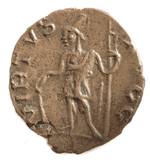
Parazonium
Encyclopedia

Dagger
A dagger is a fighting knife with a sharp point designed or capable of being used as a thrusting or stabbing weapon. The design dates to human prehistory, and daggers have been used throughout human experience to the modern day in close combat confrontations...
, wide at the hilt end and coming to a point. In the Roman mythology
Roman mythology
Roman mythology is the body of traditional stories pertaining to ancient Rome's legendary origins and religious system, as represented in the literature and visual arts of the Romans...
, it is frequently carried by Virtus, particularly on early representations. It is also sometimes carried by Mars
Mars (mythology)
Mars was the Roman god of war and also an agricultural guardian, a combination characteristic of early Rome. He was second in importance only to Jupiter, and he was the most prominent of the military gods worshipped by the Roman legions...
, or Roma
Roma (mythology)
In traditional Roman religion, Roma was a female deity who personifed the city of Rome and more broadly, the Roman state. Her image appears on the base of the column of Antoninus Pius.-Problems in earliest attestation:...
, or the Emperor
Roman Emperor
The Roman emperor was the ruler of the Roman State during the imperial period . The Romans had no single term for the office although at any given time, a given title was associated with the emperor...
, giving them the aura of courage.
In Roman statuary, the weapon is cradled in the bearer's left arm or on Trajan's column, for example, it is stuck into the left side of the officer's chest band. Existing examples on statuary show that the Parazonium's scabbard shape is a direct copy of the few existing Greek Parazoniums on display at various Greek museums. The weapon's hilt, grip, pommel are not copies of the Greek style. The pommel cap is either an eagle's head or a bi-lobed pommel. The details of the hand grip on the statues are no longer clear after 2,000 years. The guard, contrary to some reports are authentic and are a rather theatrical "S" shape with inset detail.
The Roman Parazonium blade tended to be leaf shape and approximately 15"-19" long. The use of the Roman parazonium tended to be somewhat theatrical in the sense that it was a mark of rank and it was used to rally the troops. It appears the normal procedure was for the officer to exchange his parazonium for a Gladius or a Spatha if he was directly threatened during a battle.

